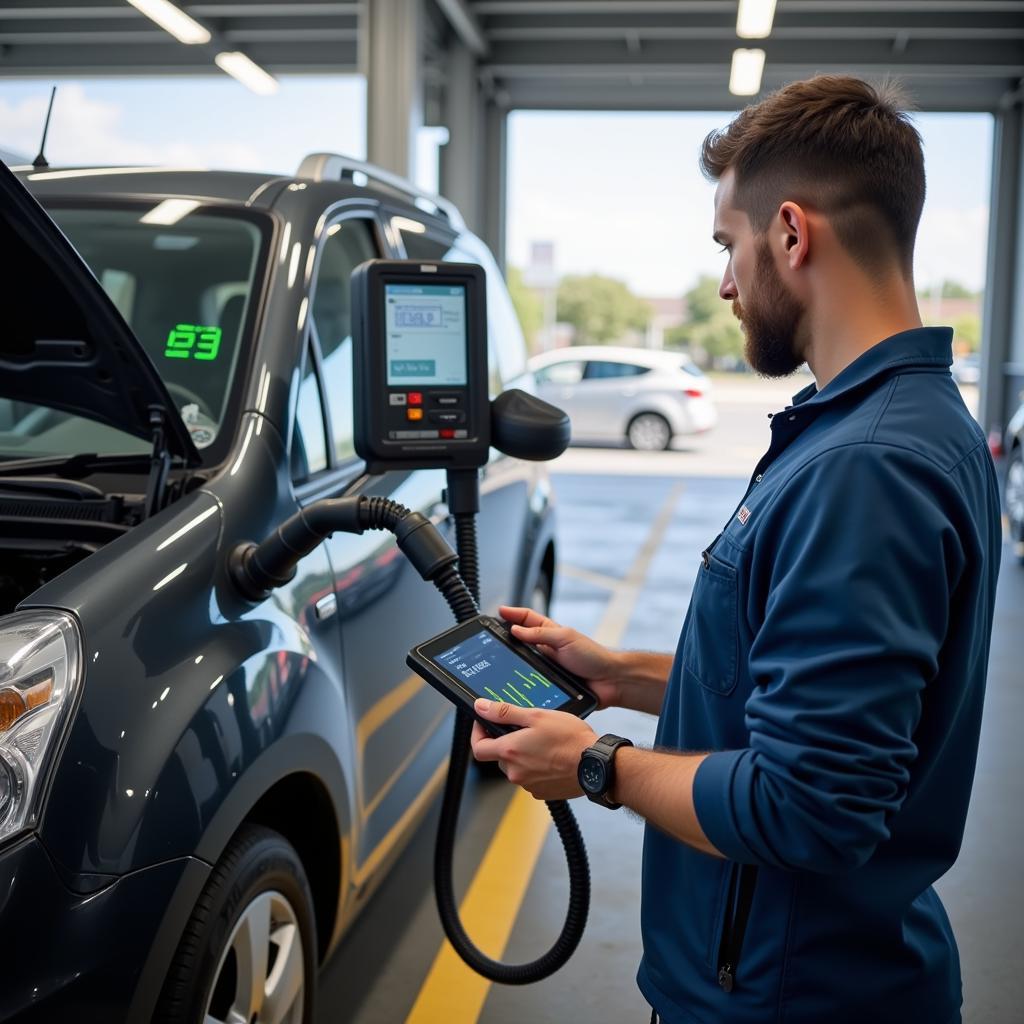Your cart is currently empty!

Understanding the VCDS Readiness Test: A Comprehensive Guide
The VCDS readiness test, also known as an OBD-II readiness monitor test, plays a crucial role in ensuring your vehicle’s emission control system is functioning correctly. This guide delves deep into the intricacies of the VCDS readiness test, providing car owners, repair shops, and technicians with the knowledge to diagnose and address emission-related issues effectively.
What is a VCDS Readiness Test?
The VCDS readiness test is a diagnostic procedure that assesses the functionality of your car’s emission control components. It uses the onboard diagnostics (OBD-II) system, accessible through the OBD-II port, to monitor various emission-related systems. The test determines if these systems have run through their complete diagnostic cycles and are operating within acceptable parameters.
 VCDS Readiness Test Screen
VCDS Readiness Test Screen
Why is the VCDS Readiness Test Important?
The readiness test is essential for several reasons:
- Emission Compliance: A passed readiness test ensures your vehicle meets the required emission standards for your region. Failing this test might lead to failing an emissions test, preventing registration renewal in many areas.
- Early Problem Detection: The test can identify potential issues with your emission control system before they escalate into major problems, saving you costly repairs down the line.
- Post-Repair Verification: After repairs on your emission control system, the readiness test verifies if the repair successfully addressed the issue.
How Does the VCDS Readiness Test Work?
The VCDS readiness test monitors various emission-related systems, including:
- Catalytic Converter: Evaluates the efficiency of the catalytic converter in reducing harmful exhaust gases.
- Oxygen Sensors: Checks the performance of oxygen sensors, responsible for monitoring the air-fuel mixture.
- Evaporative Emission System: Verifies if the EVAP system effectively prevents fuel vapor leaks.
- Exhaust Gas Recirculation (EGR): Assesses the EGR system’s functionality in reducing nitrogen oxide emissions.
- Secondary Air Injection (AIR): Evaluates the AIR system, which injects air into the exhaust to reduce emissions during cold starts.
Each system undergoes a specific driving cycle to complete its diagnostic. This typically involves a mix of city and highway driving conditions to ensure all components are tested thoroughly.
 Car Undergoing Emissions Test
Car Undergoing Emissions Test
When is a VCDS Readiness Test Required?
A VCDS readiness test is typically required:
- During annual or biennial emissions tests (depending on your location).
- After disconnecting the car battery.
- Following repairs or replacements of emission control components.
- If the check engine light illuminates, and the error code relates to an emissions system.
How to Perform a VCDS Readiness Test
You can perform the VCDS readiness test using a specialized scan tool, like the VCDS (Vag-Com Diagnostic System) interface, which offers advanced functionality for Volkswagen Audi Group vehicles:
- Connect the VCDS interface: Connect the VCDS cable to your computer and the car’s OBD-II port.
- Launch VCDS software: Open the VCDS software on your computer.
- Select control unit: Select the appropriate control unit for your vehicle’s engine model.
- Access readiness monitors: Navigate to the “Readiness” or “Onboard Diagnostics” section.
- Initiate the test: Select “Read Readiness” or a similar option to initiate the test.
- Interpret the results: The VCDS software will display the status of each monitored system as either “Passed” or “Not Passed” or “Incomplete.”
vcds readiness test abort provides a detailed guide on safely aborting the test if needed.
What if My VCDS Readiness Test Fails?
If your VCDS readiness test fails, it signifies a potential issue with your vehicle’s emission control system. Here’s what to do:
- Identify the failed component: The VCDS software will typically indicate which specific system failed the test.
- Address the underlying issue: The failed component might need repair or replacement. Consult a qualified mechanic experienced in diagnosing and repairing emissions systems.
- Repeat the test: After addressing the issue, repeat the VCDS readiness test to confirm the repair’s success.
vcds set readiness provides insights into specific procedures for certain scenarios.
Tips for Passing the VCDS Readiness Test
- Complete a proper driving cycle: Ensure your vehicle undergoes a complete driving cycle after battery disconnections or emissions system repairs. This allows the onboard computer to re-learn and monitor all systems effectively.
- Address check engine lights promptly: Don’t ignore the check engine light, especially if it relates to emissions-related issues. Addressing problems early can prevent further damage and ensure your vehicle is ready for the readiness test.
- Maintain your vehicle regularly: Regular maintenance, including oil changes, spark plug replacements, and air filter cleaning, contributes to optimal engine performance and can prevent emissions-related problems.
Expert Insights
“The VCDS readiness test is not just a formality; it’s a critical check on your vehicle’s environmental impact,” says John Miller, a certified master technician with over 20 years of experience. “Understanding the test and addressing any failures promptly ensures your car runs cleanly and efficiently.”
Conclusion
The VCDS readiness test is an integral part of maintaining your vehicle’s emission control system and ensuring compliance with environmental regulations. By understanding its importance, knowing how to perform the test, and addressing any issues promptly, you can keep your vehicle running clean, efficient, and ready to pass any emissions test.
For any further assistance or inquiries regarding VCDS tools or procedures, feel free to connect with us at +1 (641) 206-8880 and our email address: vcdstool@gmail.com or visit our office at 6719 W 70th Ave, Arvada, CO 80003, USA.
by
Tags:
Leave a Reply